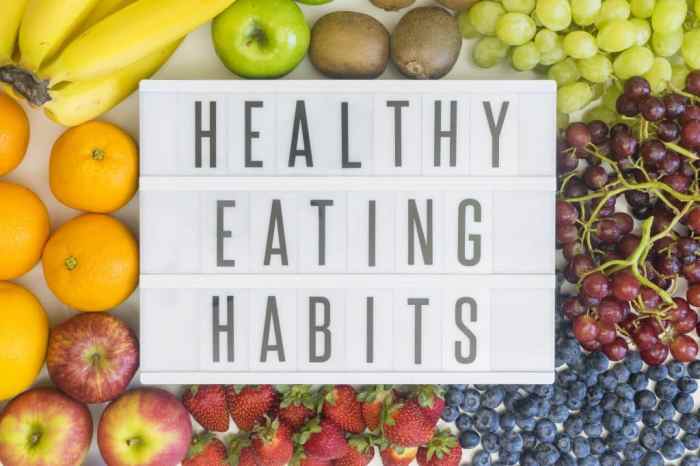Healthy Eating Habits sets the stage for this enthralling narrative, offering readers a glimpse into a story that is rich in detail with american high school hip style and brimming with originality from the outset.
Embark on a journey to discover the keys to a balanced diet and overall well-being through the lens of healthy eating habits.
Benefits of Healthy Eating Habits
Maintaining healthy eating habits, such as consuming a diet rich in fruits and vegetables, offers numerous advantages for overall well-being. These habits contribute to better physical and mental health, ultimately leading to a higher quality of life.
Rich in Fruits and Vegetables
Eating a diet abundant in fruits and vegetables provides essential vitamins, minerals, and antioxidants that support the body’s immune system and help prevent chronic diseases. These nutrient-dense foods also promote healthy digestion and weight management.
Overall Well-being
By fueling the body with nutritious foods, individuals can experience increased energy levels, improved mood, and enhanced cognitive function. Healthy eating habits are linked to better sleep quality, reduced stress levels, and a lower risk of depression and anxiety.
Impact on Physical and Mental Health
A balanced diet that includes a variety of food groups supports optimal physical health by strengthening the immune system, maintaining a healthy weight, and reducing the risk of heart disease, diabetes, and other health conditions. In addition, healthy eating habits positively impact mental health by promoting clarity of thought, emotional stability, and overall psychological well-being.
Components of a Healthy Diet: Healthy Eating Habits

Eating a balanced diet is crucial for maintaining good health and overall well-being. A healthy diet consists of a variety of nutrient-rich foods that provide essential vitamins and minerals to support our bodies. Let’s explore the key components of a healthy diet:
Essential Food Groups for a Balanced Diet, Healthy Eating Habits
- Fruits and Vegetables: These are rich in vitamins, minerals, and antioxidants that help boost our immune system and reduce the risk of chronic diseases. Aim to include a variety of colors in your daily meals to ensure you’re getting a wide range of nutrients.
- Whole Grains: Whole grains like brown rice, quinoa, and whole wheat bread are excellent sources of fiber, which aids in digestion and helps keep you feeling full for longer periods.
- Protein: Protein is essential for building and repairing tissues in our bodies. Include lean sources of protein such as chicken, fish, tofu, beans, and nuts in your meals.
- Dairy or Dairy Alternatives: Calcium-rich foods like milk, yogurt, and cheese are important for bone health. If you’re lactose intolerant or vegan, opt for fortified plant-based alternatives like almond milk or soy yogurt.
Examples of Nutrient-Rich Foods to Include in Daily Meals
- Salmon: Rich in omega-3 fatty acids, salmon is great for heart health and brain function.
- Spinach: Packed with iron, vitamins A, C, and K, spinach is a nutrient powerhouse that supports overall health.
- Quinoa: A complete protein source, quinoa is high in fiber and essential amino acids, making it a great addition to any meal.
- Blueberries: Known for their antioxidant properties, blueberries are great for boosting immunity and improving cognitive function.
Importance of Portion Control in Maintaining Healthy Eating Habits
Proper portion control plays a significant role in managing weight and preventing overeating. It’s essential to be mindful of serving sizes and listen to your body’s hunger cues to avoid consuming excess calories. By practicing portion control, you can enjoy a balanced diet while maintaining a healthy weight and reducing the risk of various health issues.
Tips for Developing Healthy Eating Habits
Eating healthy is not just about what you eat, but also about how you plan your meals, practice mindfulness, and incorporate whole foods into your diet. Here are some tips to help you develop healthy eating habits:
Meal Planning Strategies
- Plan your meals in advance to ensure you have nutritious options readily available.
- Include a variety of fruits, vegetables, whole grains, lean proteins, and healthy fats in your meal plan.
- Prepare meals in batches to save time and avoid reaching for unhealthy options when you’re busy.
Mindful Eating Practices
- Focus on your food and avoid distractions like screens or eating on the go.
- Eat slowly and savor each bite, paying attention to your body’s hunger and fullness cues.
- Avoid emotional eating by finding other ways to cope with stress or negative emotions.
Incorporating Whole Foods
- Choose whole fruits over fruit juices and whole grains over refined grains.
- Include a variety of colorful vegetables in your meals to get a range of nutrients.
- Opt for lean proteins like poultry, fish, beans, and nuts instead of processed meats.
Common Obstacles to Healthy Eating

Eating healthy can be challenging, especially with various factors that may hinder individuals from adopting nutritious dietary habits. Emotional eating, stress, convenience, and lack of time are common obstacles that can disrupt one’s eating choices.
Emotional Eating and Stress
Emotional eating often occurs as a response to feelings of stress, sadness, or boredom. Instead of eating for nourishment, individuals may turn to food for comfort or as a coping mechanism. This can lead to overeating, poor food choices, and an unhealthy relationship with food. To overcome emotional eating, it’s important to identify triggers, practice mindfulness, and find alternative ways to manage emotions such as exercise, meditation, or seeking support from a therapist or counselor.
Convenience and Lack of Time
In today’s fast-paced world, convenience often takes precedence over healthy eating. Fast food, processed snacks, and sugary drinks are readily available and require minimal preparation. Additionally, busy schedules and work commitments may leave little time for planning and cooking nutritious meals. To combat this obstacle, individuals can prioritize meal planning, batch cooking, and choosing healthier convenience options like pre-cut fruits and vegetables, whole grain snacks, and homemade meals that can be frozen and reheated. By making healthy choices more convenient, it becomes easier to stick to a nutritious eating plan.